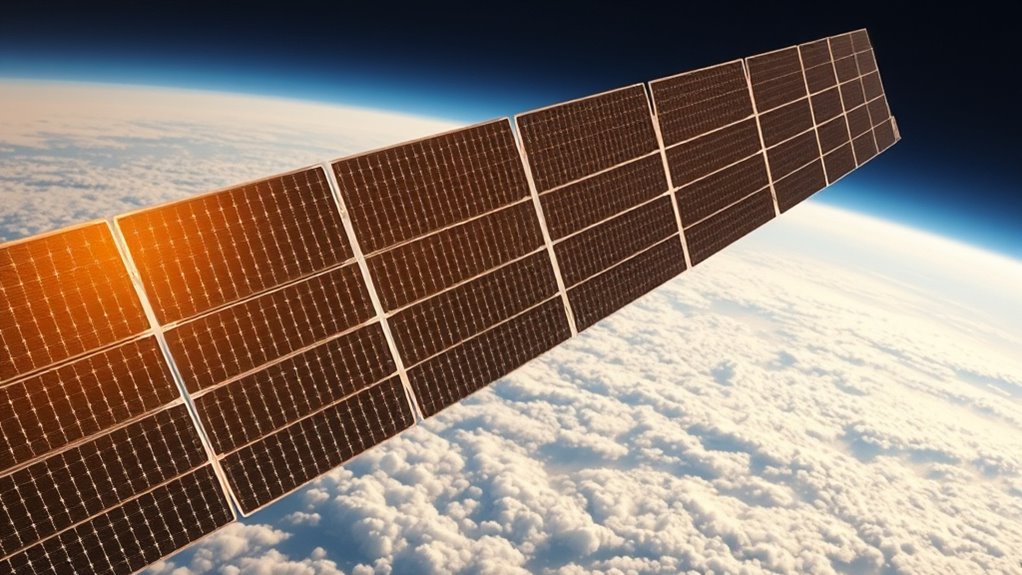Space-based solar power captures endless sunlight above the clouds, providing a reliable, continuous energy source unaffected by weather or nightfall. You can harness high-efficiency solar panels installed on orbiting platforms to send energy via microwave beams to ground stations, ensuring minimal loss. This innovative approach addresses limitations of terrestrial solar farms and offers a path to sustainable, global energy access. To discover how this technology is shaping the future, keep exploring the fascinating possibilities beyond our atmosphere.
Key Takeaways
- Space-based solar power captures continuous solar energy unaffected by weather or night, providing a reliable energy source.
- Energy is transmitted from orbit to Earth using microwaves or lasers, minimizing energy loss.
- Ground stations (rectennas) convert transmitted beams into usable electricity for the grid.
- Developing space infrastructure requires advanced materials, robotics, and precision deployment in harsh environments.
- It offers a sustainable, renewable alternative that can help address global energy needs and reduce greenhouse emissions.

Have you ever wondered if we could harness the sun’s energy more efficiently? Space‑based solar power offers a compelling answer. Instead of relying on ground-based solar panels, which are often hampered by weather, nightfall, and atmospheric interference, satellites in orbit can capture sunlight 24/7. This approach hinges on the development of orbital infrastructure—large solar collectors placed in space that convert sunlight into energy. These collectors can operate without interruption, gathering more solar energy over time than their terrestrial counterparts. Once captured, the challenge becomes how to transmit this power back to Earth effectively and safely.
Power transmission is a critical component of space‑based solar power systems. Engineers envision using high-frequency microwave beams or laser technology to beam energy down from orbit to dedicated ground stations. These stations, often called rectennas, convert the transmitted energy back into electricity that can be fed into the grid. This method promises a highly efficient transfer of energy, with minimal loss over the vast distance between space and Earth. By establishing reliable power transmission links, we can ensure a steady, clean energy supply that isn’t affected by weather, seasons, or daylight hours.
Creating the orbital infrastructure necessary for such a system requires significant innovation. Satellites would need to be equipped with large, lightweight solar panels and efficient energy conversion devices. The deployment of these structures must be precise, scalable, and capable of withstanding the harsh environment of space. Innovations in materials science and robotics will be essential to construct, maintain, and expand these orbital platforms. Additionally, advances in space technology are crucial for deploying and managing these large-scale systems effectively. Once operational, these platforms can continuously harvest solar energy, making space‑based solar power a potentially endless source of renewable energy.
The benefits extend beyond just energy efficiency. Space‑based solar power could dramatically reduce greenhouse gas emissions by supplementing or replacing fossil fuels. It also alleviates the land use issues tied to traditional solar farms, since the infrastructure is located in space. Additionally, with a global network of orbiting solar collectors, energy can be distributed to regions lacking sufficient sunlight or those suffering from energy shortages, promoting more equitable access worldwide.
In essence, harnessing the sun’s energy via orbital infrastructure and high-tech power transmission could revolutionize how we generate electricity. It might seem like science fiction now, but advances in space technology and energy transfer methods are bringing this vision closer to reality. As we refine these systems, space‑based solar power stands to become a cornerstone of our future sustainable energy landscape, offering a continuous, reliable, and clean energy source from above the clouds.
Frequently Asked Questions
What Are the Environmental Impacts of Space-Based Solar Power?
You might wonder about the environmental impacts of space-based solar power. While it offers clean energy, it could contribute to space pollution through debris from satellite launches and maintenance. Additionally, constructing and deploying these systems may cause habitat disruption both in space and on Earth. You should consider these factors when evaluating the overall environmental footprint, ensuring that the benefits outweigh potential harm to our environment and space environment.
How Does Space Debris Affect Solar Power Satellites?
Did you know there are over 23,000 pieces of orbital debris larger than 10 cm? This debris critically raises the collision risk for solar power satellites, threatening their operation. Orbital debris can damage or destroy these satellites, disrupting clean energy generation. You need to understand that managing debris is essential to guarantee the safety and longevity of solar power systems in space, preventing costly collisions and maintaining a sustainable energy future.
What Is the Cost Comparison With Terrestrial Solar Farms?
You should consider that a cost analysis shows space-based solar power has higher initial costs compared to terrestrial solar farms. While space systems require expensive launch and maintenance, they offer continuous energy and less land use. The economic feasibility depends on technological advances and scale, potentially making space-based options more viable long-term. However, current costs still make terrestrial solar farms more affordable for most regions today.
How Secure Is Space-Based Solar Power From Cyber Threats?
You should know that space-based solar power faces notable cyber vulnerabilities, mainly from satellite hacking and other cyber threats. These systems are connected to ground stations, making them susceptible to cyber attacks that could disrupt energy transmission or compromise data. To guarantee security, robust cybersecurity measures, encryption, and continuous monitoring are essential, but the risk of cyber threats remains a critical concern that requires ongoing attention and investment.
Can Space-Based Solar Power Supply Energy During Solar Eclipses?
Imagine a blackout so complete it feels like night in the middle of the day—that’s what a solar eclipse does. During such events, space-based solar power can still supply energy, thanks to its ability to maintain power continuity. Since satellites orbit above the eclipse zone, they continue harvesting solar energy and transmitting it to Earth, ensuring your power stays steady even when the sun temporarily disappears.
Conclusion
Imagine standing under a clear sky, watching the sun’s rays pour down without interruption. Space-based solar power offers that endless sunlight, unlike ground stations hidden behind clouds or nightfall. Just like a lighthouse shining through fog, satellites can harvest and beam energy directly to Earth, ensuring a reliable, clean power source. Embracing this technology means lighting the way toward a sustainable future—where our energy flows as endlessly as the sun itself.








